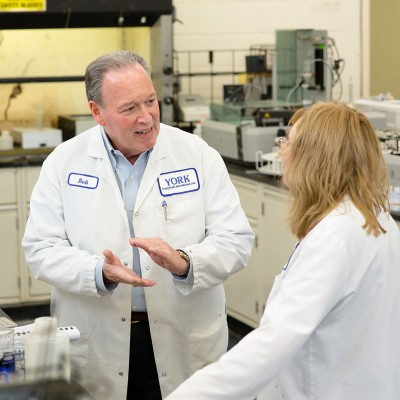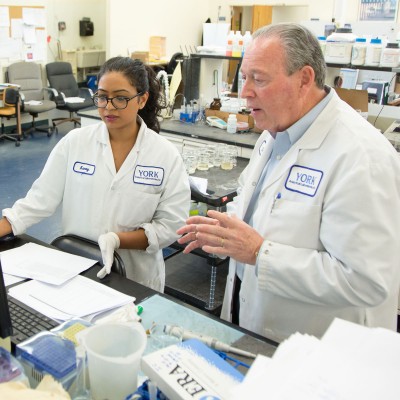 PFAS Testing Q&A with York CTO Bob Bradley:
PFAS Testing Q&A with York CTO Bob Bradley:
A Must-Read + Should-Know Overview (part 2)
Bob Bradley is a Dean of the Environmental Analysis Industry, and a Professor of PFAS Testing.
With over four decades in the environmental industry, York’s Chief Technology Officer has seen it all and had a hand in innovating new testing and methodologies that have become industry standards. In a two-part Q&A, he shares what clients should know about PFAS analytical testing challenges, its advancements, and York’s quick-strike lab capabilities.
How is PFAS Analyzed?
PFAS in environmental samples are prepared by extraction techniques and then analyzed utilizing a technique known as HPLC/MS-MS (high-pressure liquid chromatography/tandem Mass Spectrometry). This technique provides unequivocal identification and quantitative analysis of specific known PFAS species down to the low parts per trillion (ppt) levels.
Share specific challenges to PFAS Analysis.
- Sample Preparation involves extraction and concentration processes which can present challenges to laboratories – specifically to locate and use PFAS-Free solvents, containers, tubing, and others parts of the preparation systems that can contain PFAS.
- Groundwater, surface water, wastewater, and soils all present unique preparation challenges and require significant clean-up steps to remove such certain interferences.
- The Analysis systems must be PFAS free and require continual monitoring of components to assure data are not affected by trace level PFAS contamination, from items such as autosampler vials, autosampler caps, etc.
- The HPLC/MS-MS is calibrated with both isotopic and native PFAS species. These are very expensive and special handling is required to maintain their efficacy.
- A high level of chemistry expertise is required to assure data are properly acquired and reported.
Describe the sampling and testing challenges.
Sampling is critical and handling samples properly is vital for both onsite and in-laboratory testing. Onsite, any contamination as simple as hair gel can cross-contaminate samples. In the laboratories:
- Preparation of samples involves many processing steps using solid phase extraction (SPE) techniques, including multiple clean-up steps where matrix issues are encountered.
- Samples are all spiked with isotopic surrogates to monitor PFAS recoveries through extraction/preparation steps. These surrogates are specialty items and only available from a limited number of suppliers.
- Many PFAS compounds are not determined by these methods, however the most currently regulated species are: PFOA, PFOS and PFNA, and in the Tri-State area up to 24 PFAS species.
- In drinking water, the EPA has established maximum contaminant levels (MCLs) for only 2 of the PFAS species: PFOA and PFOS. Some States have regulated more and established their own “action” levels for potable water and in some cases non-potable water and soil.
 PFAS testing will become mandated to certain levels by state and federal agencies.
PFAS testing will become mandated to certain levels by state and federal agencies.
What’s York’s investment in future PFAS capabilities?
States are taking the lead on regulation for all matrices so there will be different requirements for each. As we always have with any new testing methodologies, York adapts to the changing marketplace quickly to gear up and implement any new technologies and stay atop of emerging contaminants analyses.
You’ve been involved in this industry for four decades. Is there another period of time where we’ve seen new technologies and methodologies being developed and adopted so quickly?
I have been involved in the environmental analysis industry for over four decades. The recent response to PFAS, while fast in comparison to previous emerging contaminants, is still fairly slow and was exacerbated by COVID-19. The main impetus to driving the development of analysis techniques was both public outcry and the U.S. Dept. of Defense prioritizing the need for analysis for PFAS since PFAS were used at numerous DOD sites. The DOD spent time and energy developing appropriate methodologies for use at their sites (groundwater and soil) while EPA focused mainly on the potable water side of the market.
Describe the strength of your PFAS Lab team and contributions to client successes.
During the PFAS testing development phase, we recognized the need to develop custom programs to allow for data calculations in an efficient and defensible manner especially for those procedures using isotope dilution (soil and groundwater). Our Technical Director of our Queens laboratory, Jon Walsh, is a highly experienced environmental chemist with years of experience in programming.
This allowed us to develop a unique program to address the complex isotope dilution calculations and allowed for seamless upload of data to our Laboratory Information Management System (LIMS). Technical staff in Queens who are providing sample preparation and analysis expertise include both Wenqi Li and Sandaru Giragama who are highly educated and seasoned technical staff providing best in class preparation and analysis.
You’ve been a senior leader at York for some time. Please share the York innovations and development methodologies the company has brought to the market?
York has been a leader in a number of technologies and a clear leader in client service expertise.
York was at the forefront of air analysis for volatiles organics being one of the first labs to provide this capability in the early 1980s and then again when the Clean Air Act of 1990 became a driver in 1992. York invested in multiple systems and I had the expertise to move this forward to where we are some 30 years later as one of the leaders in the analysis of air by TO-15.
In terms of PFAS testing, York was the first in NYC to develop and provide this service. Again, the vision to see the need, develop a plan and implement it demonstrates our capital resources, flexibility, adaptability and technical knowhow to move into emerging markets in a much faster lane than our competitors.
York has a number of highly experienced technical resources to provide in-depth technical expertise to our client base. This sets York apart from most laboratories with respect to 24/7 assistance to clients on highly technical issues that arise. The senior technical team of Rich August, Lidya Gulizia, Jon Walsh, Cassie Mosher and Jill Duhancik provides specific expertise to clients to solve their questions as needed.
For non-potable water and soil, 1,4-dioxane has also become part of a number of project work plans with PFAS to essentially run out its presence on a particular site.
How did York expand to the forefront of PFAS testing in the Greater NYC region?
In the spring of 2017, we recognized the need for analysis capabilities for this emerging contaminant. More technical literature was emerging regarding PFAS and its health effects. The state of New York was pushing the need for regulation as early as May 2018 and then soon after New Jersey began its approach.
York acquired its first HPLC/MS-MS system in early summer 2018. I developed the methods for preparation and analysis using isotope dilution with HPLC/MS-MS while developing and implementing methods for drinking water using EPA methods 537 and 537.1. I was then able to procure certification from the New York State Dept. of Health (NYSDOH) and State of Connecticut Dept. of Health (CTDOH) once for PFAS in drinking water.
In 2019, we expanded the Queen’s lab to open the first and only PFAS and Emerging Contaminants laboratory in New York City.
I also researched and developed a technique (TOP Assay: Total Oxidizable Precursors) to assist environmental consultants to determine more than the simple list of 24 PFAS species typically examined (there are now over 5,000 PFAS species). Many groundwater sites that have been impacted by PFAS use typically have PFAS precursors (PFAS species used in the manufacture or used in specific products) that may be helpful for remediation strategies.
This TOP Assay analysis is a complex preparation involving controlled oxidation of these total oxidizable precursors to yield known PFAAs (perfluoroalkyl acids). These approaches are still evolving since there is no properly promulgated EPA reference method for analysis for non-potable water and soil that meets the action levels established in the tri-state area.

